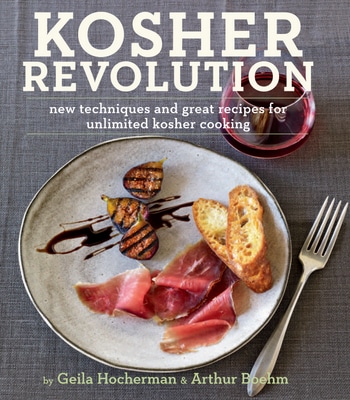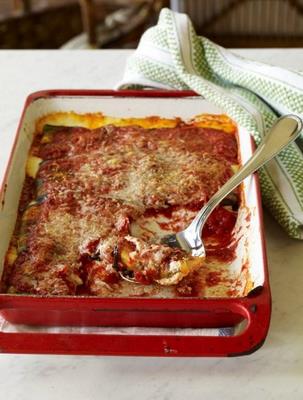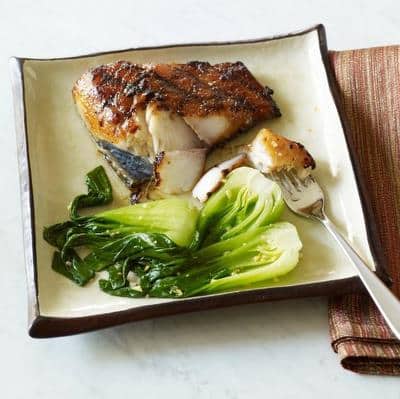
The Kosher Revolution by Geila Hocherman & Arthur Boehm is more than just a cookbook, it’s an education. With formal training using nonkosher ingredients, Gila attempts to revolutionalize traditional kosher cooking and elevate it into modern and sophisticated cuisine. Using groundbreaking techniques, she guides you in converting any recipe into a kosher one. In Chapter 1, you’ll learn Gila’s revolutionary subbing techniques to match the flavor and texture of any dish. The following chapters will take you on a culinary journey through international kosher cuisine. Recipes like Duck Prosciutto, lentil soup with “ham” and surimi crab cakes, are a lesson in using the “kosher revolution” approach. Other recipes such as Peshwari Challah, Onion-Stuffed Knaidlach, and Chicken Livers with Warm Cognac Vinaigratte elevate traditional kosher cuisine into gourmet fare that is anything but ordinary. Many of the recipes guide you in exchanging one or more ingredients to create a a meat, dairy or pareve version. In addition, an indispensable ingredient-exchange chart is included at the end of the book, as well as a list of shopping sources. With 95 recipes, countless tips and invaluable wisdom, this cookbook is a must-have for foodies everywhere, kosher and non-kosher alike.
We are giving away one free copy of The Kosher Revolution Cookbook. To enter, share with us your ideas on revolutionalizing kosher cuisine in the comments below. How do you up the ante on traditional kosher dishes? A winner will be chosen at random on Friday, November 11th, 2011.
{Update, November 11th, 2001: the winner of the Kosher Revolution cookbook giveaway is…drumroll….Leah Abraham! Congratulations Leah!}
BONUS RECIPES

Eggplant Rollatini
serves 6
Baked eggplant slices rolled around a meatless filling is a kosher favorite. My version ups the traditional ante as its served with a sauce that includes smoky red peppers, a great eggplant counterpoint, plus creamy mascarpone. The dish is luscious but light, and can also be made ahead, see my Tip. It’s a great family favorite too.
Geila’s Tip: You can prepare the filling and/or sauce ahead and refrigerate. Or bake the dish ahead, allow it to cool, and refrigerate. Reheat in a 300°F oven and serve.
Ingredients:
3 medium eggplants, sliced lengthwise 1/3 inch thick (about 18 slices)
2 tablespoons plus 2 teaspoons kosher salt
One 28-ounce can peeled plum tomatoes
2 roasted red peppers (see Step 3, page 48)
2 large basil sprigs
6 puréed roasted garlic cloves
2 sprigs fresh oregano, or 2 teaspoons dried
1/4 cup extra-virgin olive oil
One 15-ounce container ricotta
1/2 cup mascarpone
1/8 to 1/4 teaspoon freshly grated nutmeg, to taste
1/2 cup grated Parmesan
1. Place the eggplant slices on paper towels and sprinkle on both sides with the 2 tablespoons salt. Allow the slices to release their bitter juices, 20 to 30 minutes.
2. To make the sauce, cut the tomatoes in large chunks, combine with the peppers in a medium bowl and purée with an immersion blender, or in a food processor. Heat a large skillet over medium-high heat. Add the tomato and pepper purée, basil, garlic, oregano and 1 teaspoon of the salt, bring to a boil, reduce the heat, and simmer until the flavors are blended, 15 to 20 minutes. Set aside.
3. Meanwhile, preheat the oven to 350ºF. Cover 2 medium cookie sheets with foil and brush with the olive oil.
4. Wipe the excess salt from the eggplant, roll in the paper towels and squeeze the rolls gently to remove more moisture. Transfer the eggplant to the cookie sheets, and bake until tender and somewhat translucent,15 to 20 minutes. Cover the slices with foil (to trap steam that will prevent the eggplant from sticking to the pan) and allow to cool.
5. Meanwhile, in a large bowl, combine the ricotta, mascarpone, nutmeg and the remaining teaspoon salt. Transfer half of the tomato sauce to a 8 x 12-inch baking dish.
6. With your hands, and using 2 to 3 tablespoons of the cheese mixture,make roll-shapes. Place one part way down from the wide end on an eggplant slice, roll to enclose it, and transfer to the baking dish seamside down. Repeat with remaining cheese mixture and slices. Spoon the remaining tomato sauce over the eggplant, sprinkle with the Parmesan,and bake until tender, about 20 minutes. Let rest for 5 to 10 minutes before serving.

Miso-Glazed Black Cod
serves 6
New York’s Nobu restaurant, 1985: Chef Nobu Matshushia’s miso-glazed black cod. Me on first taste: Wow! I longed to make a kosher version of this great dish, but had to bide my time until kosher miso and sake became available. On that happy day I set to work—and here it is, a dish you’ll enjoy often and that’s baby-simple to make. All you do is marinate black cod in a simple miso-sugar mixture then broil or grill it. The caramelized skin is delightfully crispy, and really compliments the sweet, moist flesh. Served with Baby Bok Choy with Garlic (page 136)—or by itself with any bitter green—this is stellar dining.
Geila’s Tips: This also makes an elegant starter. Just reduce the portion size by half andserve the cod on greens lightly dressedwith Asian Vinaigrette (page 32). I also use this glaze brushed one eggplant when I grill it. Serve the eggplant with roasted meat.
Ingredients:
1/2 cup mirin
1/2 cup sake or dry white wine
11/4 cups white miso
2/3 cup sugar
6 black cod fillets (6 to 8 ounces each), skin removed
1. In a medium heavy-bottomed saucepan, combine the mirin and sake and bring to a boil. Boil for 1 minute (to cook off the alcohol), reduce the heat to medium, add the miso, and stir until dissolved. Add the sugar,increase the heat, and stir until the sugar is dissolved, about 5 minutes. Remove from the heat and cool to room temperature.
2. Dry the fillets with paper towels and put them in a gallon-size sealable plastic bag. Add the miso glaze, seal and refrigerate for 24 to 48 hours.
3. Bring the fillets to room temperature. Preheat the broiler or place a grill pan or heavy skillet over high heat. Wipe excess glaze from the fillets and broil or grill, turning once, until brown and glazed, about 8 minutes. Transfer to plates and serve.

I often try to intensify the flavors of traditional dishes with fresh herbs, homemade stocks and good wines!! I also look to cut unnecessary fat in dishes when possible.
I like to use unconventional ingredients in my cooking…that my family doesn’t always agree upon! My salted caramel ice cream is kind of proof of that :)
I heard about that :)
Most traditional Jewish recipes are heavy on the oil. Besides for substituting healthier oils (olive, etc) for oil and margarine, I find that a lot of recipes don’t really need as much oil as they say and Pam works wonders on a skillet!
I re-adapt “impossible” recipes that use pork, shellfish, etc. and substitute kosher ingredients, opening up an entire arena of possibilities for kosher cooking!
I try to avoid recipes that involve “mystery” ingredients to make a dish pareve. Non-dairy whip has hydrogenated oils, which is hard on the body. Margarine – no.
I’m trying recipes now with agar (a seaweed that can serve as gelatin while being high in fiber) and coconut oil instead of margarine. For cake, I dug up a recipe of pulverized cashews, which made a wonderful cream.
It’s an acquired taste!
My blog, Kitchen Tested, is all about unconventional Kosher recipes. I get a lot of inspiration from recipes I see on TV and I like to make them more accessible for the Kosher world. My latest is Vegetarian “Frito” Pie! So good!!!
Curios to lear how to cook with this book!
I use fresh herbs and real wine, not cooking wine.
I like to take traditional jewish cooking and put a more modern spin on it!!
I like to use alot of fresh and natural ingriedents in cooking and I like to expirment and combine flavors to make unique twists on classic recipes
I adapt the non kosher recipes using kosher ingredients.
I try to avoid lots of processed ingredients and sugar in savory dishes. I use olive oil, coconut oil, whole grains, coconut milk and other nut milks.
I like to spice things up with curry! It makes everything taste better!
lots of fresh ingredients.
I substitute applesauce and olive oil for margarine and dont use oil for frying eggs, pancakes etc
Like the other posters, I try to rely on fresh ingredients that are as close to real as possible. I also try to avoid the overly sweet dishes that seem to always be prevalent in kosher menus (sweet orange chicken, sweet potato kugels, cranberry crisp kugel, etc.) in favor of savory foods. Once you get away from sweet, there are so many other flavors to explore!
I couldn’t agree more, Robin. I definitely grew up on those things, and I really try to push myself in the savory direction!
Presentations on the plate needs to impress, since we eat with our eyes first.
food needs to look good as well as taste delicious. I love reading cookbooks and magazines with color photos. Would love to win this new and innovative cookbook.
I love making the traditional foods but to add little twists. We like gefilte fish with garlic and paprika topped with onions…. Not sweet – no carrot ;-)
I go by my tastebuds. When there is a flavor I crave I just spice accordingly. There are so many cuisines that distinguish themselves by their spices and herbs. Educating myself and my tastebuds with how to use these spices lends me the opportunity to invite many different cultural cuisines in to my home.
I experiment with Sephardic dishes – particularly Moroccan. There is definitely truth to the concept that a Mediterranean diet is healthier.
i always use less oil/margarine than called for and use the freshest ingredients available
I kind of like to experiment. Trial and error style. Of course, not when I’m having guest over! The experiments I save for family ;)
I do the same thing… I will never try a new recipe when guests come!
I use Mocha mix when recipes call for milk in meat dishes.
I like to add fresh herbs to my food. It adds lots of flavor-and a good kick to a simple recipe.
I try and do a few things to traditional recipes.
A. I always try and find a way to make it healthier. Most traditional foods have way to much oil.
B. My food not only has to taste good, it always has to look good, even if it is just us.
Living in Hawaii and not having access to ready made processed Kosher foods, I like experimenting with the local island produce in the traditional Jewish dishes!
I love most traditional Kosher foods, but like to prepare them with a twist! How bout some chicken balls for your bubby’s chicken soup? Or Susie Fishbein’s beautiful tri colored matzah balls?
I love gefilte fish, but just as BIB’s Chanie, I like to prepare it in lots of different ways. My favorite is a tri colored layered gefilte fish (again from Susie F.) that comes out delicious and really beautiful!
Nothing too revolutionary (unless you’re asking my Bubby M.) just a little twist.
I like to try a new recipe every Shabbos, often from different cuisines. The various spices and sauces do wonders to add flavor to my cooking- and I adapt whatever necessary using soymilk and margarine.
I get inspiration from non-kosher restaurant menus and cookbooks and then I adapt the recipes. There is no reason that we have to be limited to a few options. There is so much we can do with fresh herbs and spices. I love experiments with ethnic foods. I tend to cook a lot of indian and thai food.
A recipe made with fresh colorful ingredients and the presented beautifully is sure to satisfy and consumer!
I come to BIB to get new ideas :) (and it never fails me!) BTW my daughter LOVED her birthday strawberry shortcake cake and so did everyone else. One guest even asked where I bought it :)
Like others, I use fresh local ingredients and as few processed foods as possible. I like to look up recipes on the internet for a main ingredient or two, for example, spaghetti squash and mushrooms, and see if I can create something with the ingredients I have based on the recipes that come up.
I try to avoid frying and using loads of oil like many traditional kosher recipes call for. Foods can still taste good without being drenched in oil!
I also find that using soy milk is a pretty good alternative in dairy recipes.
I substitute spelt white flour for regular flour when I make. Challah, it tastes the same and I find it to be lighter and much easier to digest.
I like watching shows like iron chef or anything with Alton Brown because he explains the ingredients both by taste and “purpose”, which teaches me how to use the kosher ones and what kind of taste or texture to seek out in substituting the not kosher ones.
I would like my kosher cooking to be revolutionized, through showing me how to turn simple kosher recipes into something exotic and beautiful on the presentation.
Love her book ! :)